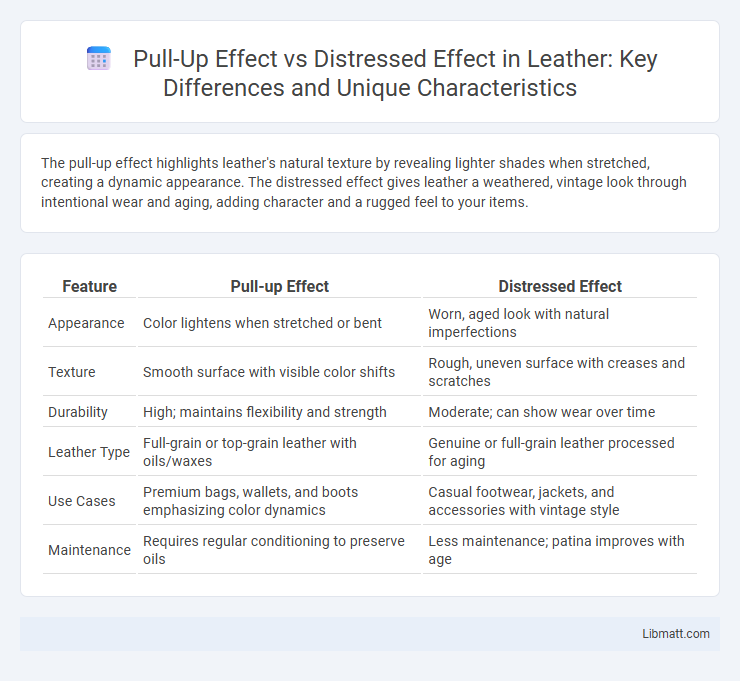The pull-up effect highlights leather's natural texture by revealing lighter shades when stretched, creating a dynamic appearance. The distressed effect gives leather a weathered, vintage look through intentional wear and aging, adding character and a rugged feel to your items.
Table of Comparison
| Feature | Pull-up Effect | Distressed Effect |
|---|---|---|
| Appearance | Color lightens when stretched or bent | Worn, aged look with natural imperfections |
| Texture | Smooth surface with visible color shifts | Rough, uneven surface with creases and scratches |
| Durability | High; maintains flexibility and strength | Moderate; can show wear over time |
| Leather Type | Full-grain or top-grain leather with oils/waxes | Genuine or full-grain leather processed for aging |
| Use Cases | Premium bags, wallets, and boots emphasizing color dynamics | Casual footwear, jackets, and accessories with vintage style |
| Maintenance | Requires regular conditioning to preserve oils | Less maintenance; patina improves with age |
Introduction to Pull-Up and Distressed Effects
Pull-up effect and distressed effect are popular techniques in leather finishing that enhance the material's aesthetic and character. Pull-up effect occurs when leather is stretched or pulled, causing temporary lightening of the color, which reveals its natural texture and grain, ideal for highlighting your hides' authenticity. Distressed effect involves artificially aging leather to create a worn, vintage appearance with permanent creases, scratches, and color variations that add depth and uniqueness to leather goods.
Defining the Pull-Up Effect
The Pull-Up Effect occurs when bond prices rise due to a decline in interest rates or credit risk, causing yields to fall and pushing prices upward. This effect contrasts with the distressed effect, where bond prices drop sharply due to increased default risk or financial distress of the issuer. Understanding the Pull-Up Effect helps You anticipate changes in bond valuation during improving credit conditions.
Understanding the Distressed Effect
The distressed effect mimics natural aging and wear on materials, creating a rugged, vintage appearance often used in furniture, leather goods, and textiles. This effect emphasizes irregularities, scratches, and faded areas that add character and uniqueness to the item. Understanding the distressed effect helps you choose designs that convey authenticity and timeless charm in your decor or fashion.
Key Differences Between Pull-Up and Distressed Effects
Pull-up effect occurs when leather darkens and lightens as it is stretched and compressed, highlighting its natural texture with a smooth, polished look. Distressed effect, on the other hand, artificially ages leather by creating scratches, scuffs, and worn patches that give a rugged, vintage appearance. Your choice depends on whether you prefer the dynamic, natural patina of pull-up leather or the intentional, weathered character of distressed finishes.
Materials Best Suited for Each Effect
Pull-up effect is best suited for vegetable-tanned leathers because this material lightens when stretched, highlighting natural variations and giving a vintage, worn-in look. Distressed effect works well on thicker, sturdier leathers such as full-grain or top-grain, where sanding, abrasion, or washing techniques create an aged, rugged appearance without compromising the leather's durability. Your choice of leather should align with the desired visual impact and longevity of the finished product.
Techniques for Achieving the Pull-Up Effect
Techniques for achieving the pull-up effect include using vegetable-tanned leather, which darkens and develops a rich patina when stretched or flexed. Applying oils or waxes enhances this characteristic by allowing the leather to lighten in areas of tension, highlighting texture and depth. Your leather goods benefit from this process through unique visuals that emphasize natural wear and personalized aging.
Methods for Creating a Distressed Look
Distressed effects are achieved through physical techniques such as sanding, scraping, or using wire brushes to wear down the surface, simulating natural aging. Chemical methods like applying oxidizers or specialized paint treatments enhance the texture and depth, creating a flaky or cracked appearance. You can combine multiple approaches to achieve a unique, authentic distressed finish that contrasts with the cleaner pull-up effect, which primarily relies on stretching and natural patina development.
Aesthetic Appeal: Pull-Up vs Distressed
Pull-up leather offers a rich, dynamic aesthetic where lighter shades emerge when the leather is stretched, creating a vibrant and polished finish that evolves with use. Distressed leather presents an aged, rugged look characterized by natural marks, creases, and a matte surface that enhances its vintage charm and authenticity. Your choice between pull-up and distressed hinges on whether you prefer a refined, changing sheen or a consistently weathered, textured appeal.
Maintenance and Longevity Comparison
The pull-up effect enhances leather durability by creating a natural patina through regular bending and stretching, which maintains the material's suppleness over time. In contrast, the distressed effect involves intentional surface abrasion and aging, which can reduce leather's protective layers and potentially accelerate wear without proper care. Regular maintenance such as conditioning and gentle cleaning extends the longevity of both finishes, but pull-up leather generally withstands daily use better due to its dynamic response to movement.
Choosing the Right Effect for Your Project
Selecting between the pull-up effect and distressed effect depends on the desired aesthetic and durability requirements of your project. The pull-up effect showcases natural leather's unique character by highlighting color variations when stretched, ideal for premium, high-quality leather goods emphasizing authenticity. The distressed effect offers a vintage, rugged look by artificially aging the leather, suitable for casual or rustic designs where a worn, textured appearance enhances the product's visual appeal.
Pull-up effect vs distressed effect Infographic

 libmatt.com
libmatt.com